
- Vintage Sterling Silver
- Base Metal
- Department
- Metal
- .925 Sterling Silver (3)
- 925 Silver (3)
- 925 Sterling Silver (5)
- Brass (7)
- Fine Silver (10)
- Rose Gold (2)
- Rose Gold Plated (5)
- Silver (330)
- Silver Plated (10)
- Sterling Silver (2878)
- Sterling Silver .925 (2)
- Sterling Silver 925 (5)
- Sterling-silver (3)
- White Gold (2)
- White Gold Plated (30)
- Yellow Gold (7)
- Yellow Gold Plated (26)
- Other (751)
- Shape
- Style
- Vintage
Antique Vintage Victorian Sterling Silver English Chased Wedding Bangle Bracelet
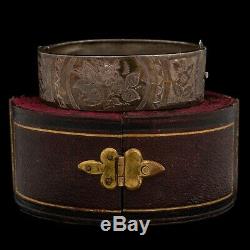
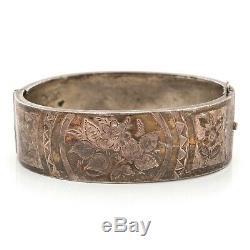
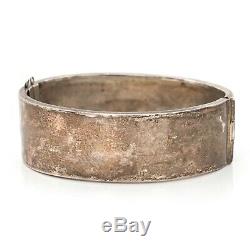
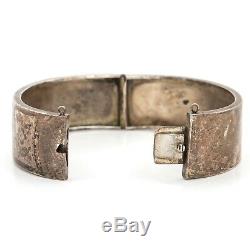
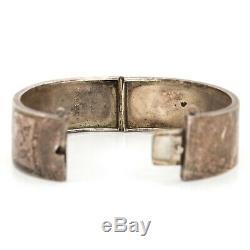
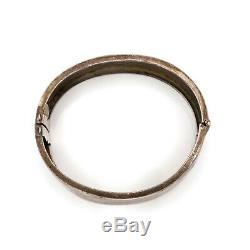
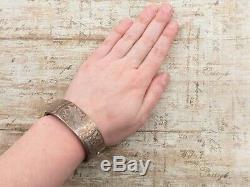


We have similar Victorian, and Wedding items, which would pair nicely with this piece, for sale this week. Listing Description by: Jane T.
Markings : Sterling silver lion hallmark, Birmingham anchor assay mark, date letter n for the year 1888-89 and an unidentified maker's mark J. On the inside of the band. Country of Origin : United Kingdom.
Gram Weight : 22.4 Grams. Wearable length and inner circumference, not including the wrist gap. Wrist gap measures: 2.3. When opened, the wrist gap measures an additional: 2.45. Bracelet Type : Hinged bangle bracelet. Link Type : Rounded and polished sterling silver. This hinged bangle was handmade during the Victorian era in England as a wedding bracelet. The bracelet features floral, vine patterns, using the "chasing" metalworking technique to create etched designs on the surface of a hand-hammered silver band.The bangle is hinged with a box clasp. The bracelet is missing its safety chain, however it is completely secure when worn and if desired your local jeweler can add a safety chain.
The price has been reduced to reflect this. This listing is for the item only. The Victorian era took place from the year 1836 to the year 1901, which was the span of Queen Victorias reign.
Queen Victorias style was undoubtedly influential on the fashions of her country and ultimately led to three distinct jewelry trends emerging from the era. The first of these three styles was the Romantic period. The Romantic period was impacted by the Georgian period, which preceded it. The second period was the Grand period, which was primarily defined by mourning jewelry and the trends surrounding it. The final period was the Aesthetic period.
The Aesthetic period was more lighthearted and airy than the previous periods and focused on aesthetic beauty and joy. This era features floral, natural, and feminine motifs, and utilized chased gold designs, enamel, and seed pearls. Wedding bracelets have a long history stretching back centuries and were especially popular in 19th century Europe as Victorians looked back to the Middle Ages and Renaissance for influence in their art and jewelry. Historically, a groom would give his bride a beautifully engraved bracelet on their wedding day, but occasionally they would also be gifted in setsone given upon engagement, and the other on the day of the wedding. Alternately these sets would come as two different sized bracelets, a larger one for the groom and the smaller for the bride. During the Victorian and Art Nouveau eras, these bracelets were also referred to as handcuff bracelets and were a symbol of matrimonial commitment, usually used in place of an engagement or wedding ring. Repoussé began as an ancient metalworking technique dating as far back as the 3. Century BC, involving malleable metal that was hammered onto the reverse side to create an image on the front. Examples are found all over the world; Greece, Egypt, and even the Hopewell periods in the American southeast. Reverse side hammering was also used to add detail to the front, creating intricate patterns using grooves, indentations, and channeling.The piece was then carefully polished to create a hollow, eye-catching treasure. Chasing is a metalworking technique that uses a nail-like tool and hammer to hand etch patterns onto a metal surface. This process creates a design that is sunk into the front of the surface using indentations, grooves, and channels. Chasing is thousands of years old and was a very difficult and time-consuming technique that is still used by metalsmiths today. The item "Antique Vintage Victorian Sterling Silver English Chased Wedding Bangle Bracelet" is in sale since Saturday, February 15, 2020.
This item is in the category "Jewelry & Watches\Vintage & Antique Jewelry\Fine\Victorian, Edwardian 1837-1910\Bracelets". The seller is "abeautifultimeco" and is located in Fort Collins, Colorado.
This item can be shipped worldwide.
- Modified Item: No
- Country/Region of Manufacture: United Kingdom
- Style: Bangle
- Metal Purity: .
- Metal: Sterling Silver
- Era: Victorian

